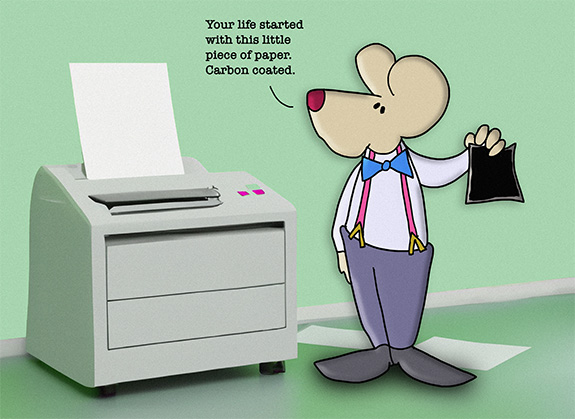These days, we don’t think twice about asking this question of someone.
“Hey. Will you send me a copy of that?”
Within seconds, that “copy” shows up on our smartphone or on our laptop. Bazzzingggooo. And it is there. Like magic. Like Star Trek.
There was a time when getting a copy of something wasn’t quite so easy. For centuries, copying a single document was a slow, arduous process, done mostly by hand. But everyone was thinking the same thing. “It sure would be nice if we could get a copy of that. Pronto.”
Hang on just a second. Sidebar here.
Pronto. Now, how did we ever start saying “pronto?” Pronto is an adverb meaning promptly or quickly. If someone asks you to do something pronto, they want it done now. Do it fast. Well, it turns out this word comes from Italian. Sort of. It is the Italian cognate of the Spanish word pronto and has been used in English by 1740 in musical instructions. It originally meant to play music quickly.
It sounds more like the name of a horse.
Anyway. Back to making copies.
Centuries ago, inventors had long sought a device to automate the process, with limited success.
Our good man Thomas Jefferson used a pantograph. A contraption. As he wrote, a wooden device connected to his pen manipulated another pen in precisely the same movements, creating a mechanical copy. And then there was steam-engine pioneer James Watt. He created an even cruder device that would take a freshly written page and mash another sheet against it, transferring some of the ink in reverse. I guess you’d have to hold it up to a mirror to read it.
Well, I think the thing that turned the tides is what I am writing about today. It was quite a significant thing.
On October 7, 1806, that extremely magical invention called carbon paper was patented in London by inventor Ralph Wedgwood.
Yes. Carbon paper. I used to love the stuff.
As most of us know, carbon paper (originally carbonic paper) consists of sheets of paper that create one or more copies simultaneously with the creation of an original document when inscribed by a typewriter or ballpoint pen. Heck. Pencil will work if you press hard enough.
The logistics of it go this way: Carbon paper in its original form was paper coated on one side with a layer of a loosely bound dry ink or pigmented coating, bound with wax.
Carbon paper led the way. It opened the door for things like the mimeograph machine. That device came on the scene in the early 20th century. The mimeograph machine used ink to produce a small set of copies, but it weaker with each duplication. Not so great.
Eventually, a bulky, unfriendly photocopier emerged.
But. But. In 1959, Xerox released the “914”—the first easy-to-use photocopier. We haven’t looked back since.
The “true” era of copying began. Or, more accurately, the explosion of copying began.
Xerox expected customers would make about 2,000 copies a month—but users easily made 10,000 a month, to begin with. Some say it was as many as 100,000.
Before the 914 machine, Americans made 20 million copies a year, but by 1966, Xerox had boosted the total to 14 billion.
Heavy only knows how many copies are being made today on the digital airways. Copies of emails, work documents, recipes, address cards, and a myriad of other things. Anythings. Everythings.
And carbon paper led the way, having its birth on October 7, 1806. Copy that.
“””””””””””””””””””
In everything truth surpasses the imitation and copy.
— Marcus Tullius Cicero
“””””””””””””””””””
Be the best version of yourself rather than a bad copy of someone else!
— Conchita Wurst
“””””””””””””””””””
When a thing has been said and well, have no scruple. Take it and copy it.
— Anatole France
“””””””””””””””””””
Copy that. Like a copy cat. Two, two, and two.
